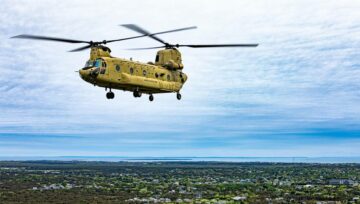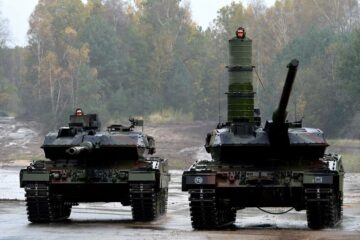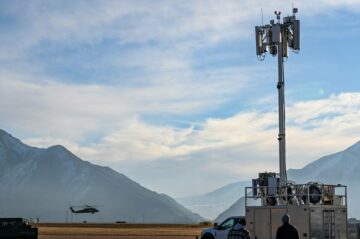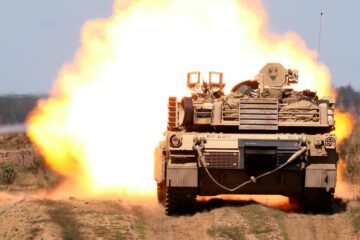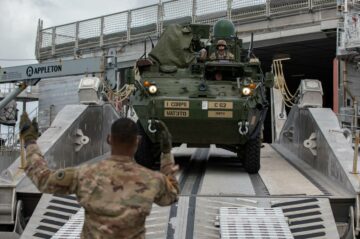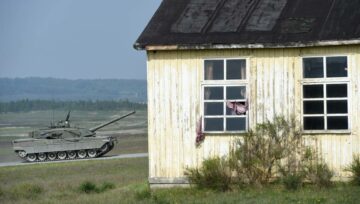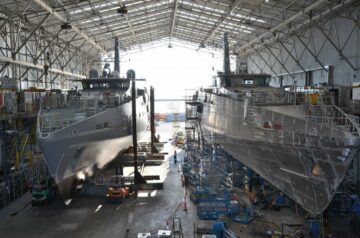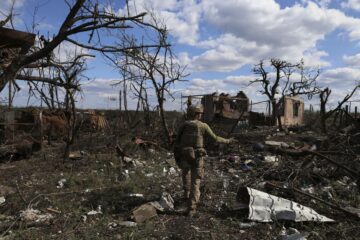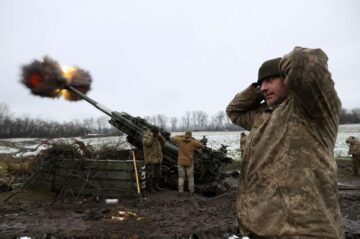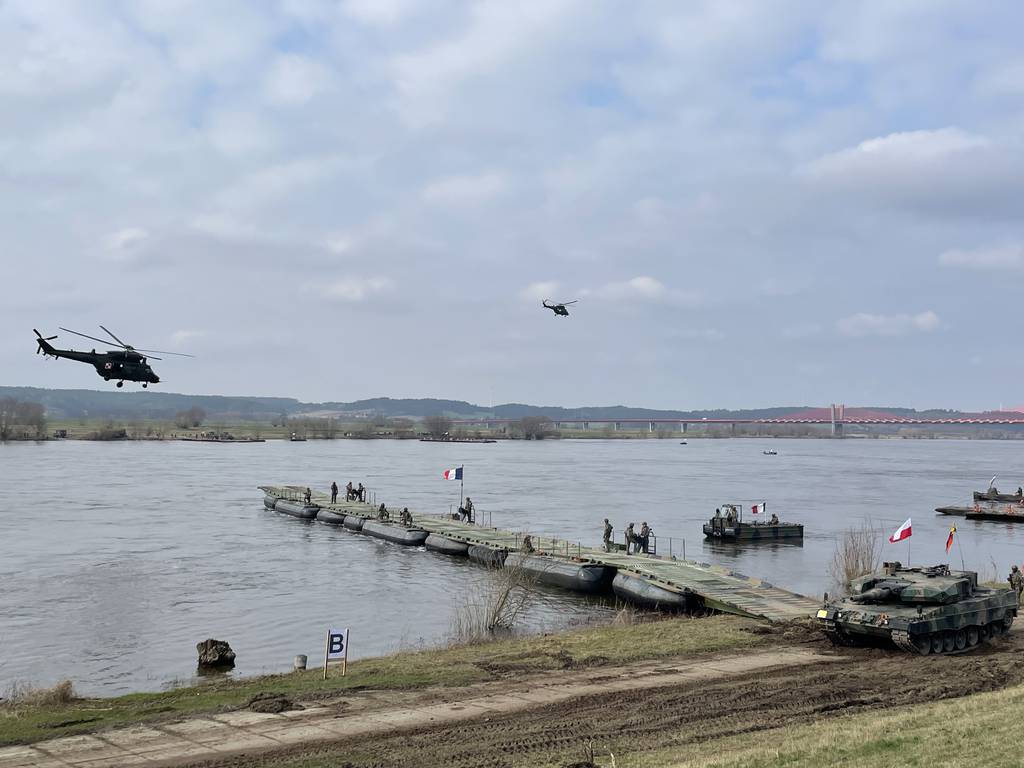
KORZENIEWO, Poland — Some one hundred kilometers away from Poland’s border with the Russian exclave of Kaliningrad on the Baltic Sea, forces from nine NATO member countries were busy setting up the last of their amphibious gear.
They are part of a large multi-domain operations exercise that entails a notoriously tricky river crossing in the remote northern Polish countryside here, as European officials are worried about the possibility of a Russian attack, depending on the outcome of the war in Ukraine.
As part of the Polish-led Dragon-24 military exercise, organized here on March 4-5, American, British, French, German, Spanish, Turkish, Slovenian and Lithuanian soldiers traveled across the 320 meter “wet gap” crossing of the Vistula River, a military jargon term for traversing rivers and swamps.
It was no coincidence that the winter time was chosen by the Polish Armed Forces to host this event, as the waterway can be especially difficult to navigate in this season, according to Maj. Gen. Cezary Wiśniewski, a senior military official.
“We chose this time because we wanted the most challenging conditions – the water levels of the river are very high and the winds are usually strong,” he told reporters during a media briefing.
During his presentation, the official noted some of the key objectives of the training: synchronizing forces conducting defense in cooperation with non-military defense system in crisis and small-scale armed conflict; assessing logistics capabilities as part of the lessons learned from the war in Ukraine; and practicing cooperation between front and rear logistic support elements.
The river crossing entailed the positioning of countries’ floating bridges, which then had to be loaded with tanks, to navigate from the opposite side of the bank from point A to point B and dock safely for the vehicles to disembark and continue their path.
The simulated crisis also includes the movement of a large number of personnel and combat vehicles across Polish territory, an element Wiśniewski said is key.
“The movement of troops is a crucial part of the exercise, as the rapid deployment of forces from the west to the east of Poland is both important and challenging – especially in a situation like today where we have large formations of troops involved, with 20,000-plus military personnel and 3,500 pieces of equipment,” he said.
A tactical road march is set to begin later this week from Korzeniewo, where both wheeled and tracked military vehicles will cover approximately 300 kilometers over the span of multiple days toward the Bemowo Piskie training area.
They will navigate public roads and forested areas while also being faced with ambushes, sabotage, misinformation as well as “Little Green Men,” as media briefing called them. The term is a reference to the 2014 Russian occupation of Ukraine’s Crimea peninsula, which involved Russian soldiers equipped with weapons but dressed with unmarked green military uniforms.
The Polish national drill is part of the larger-scale Steadfast Defender-24 exercise organized by NATO, which will run until the end of May.
According to a recent statement published by the Polish Ministry of Defense, while both exercises are defensive ones and not directed against any state, they are deemed to be “a demonstration of the ability to counter any aggressive policies and provocative activities of the Russian Federation.”
Elisabeth Gosselin-Malo is a Europe correspondent for Defense News. She covers a wide range of topics related to military procurement and international security, and specializes in reporting on the aviation sector. She is based in Milan, Italy.
- SEO Powered Content & PR Distribution. Get Amplified Today.
- PlatoData.Network Vertical Generative Ai. Empower Yourself. Access Here.
- PlatoAiStream. Web3 Intelligence. Knowledge Amplified. Access Here.
- PlatoESG. Carbon, CleanTech, Energy, Environment, Solar, Waste Management. Access Here.
- PlatoHealth. Biotech and Clinical Trials Intelligence. Access Here.
- Source: https://www.defensenews.com/global/europe/2024/03/05/amid-russia-jitters-nato-drills-flowing-troops-across-polish-rivers/
- :is
- :not
- :where
- $UP
- 10
- 20
- 2014
- 300
- 320
- 500
- 70
- a
- ability
- About
- According
- across
- activities
- against
- aggressive
- also
- American
- Amid
- an
- and
- any
- approximately
- ARE
- AREA
- areas
- armed
- AS
- Assessing
- attack
- aviation
- away
- b
- Bank
- based
- BE
- because
- begin
- being
- between
- border
- both
- bridges
- Briefing
- British
- busy
- but
- by
- called
- CAN
- capabilities
- challenging
- chose
- chosen
- coincidence
- combat
- conditions
- conducting
- conflict
- continue
- cooperation
- Counter
- countries
- cover
- covers
- crisis
- crossing
- crucial
- Days
- deemed
- Defense
- defensive
- Depending
- deployment
- difficult
- directed
- Dock
- during
- East
- element
- elements
- end
- entails
- equipment
- equipped
- especially
- Europe
- European
- Event
- Exercise
- exercises
- faced
- Federation
- floating
- Flowing
- For
- Forces
- French
- from
- front
- Gear
- Gen
- German
- Green
- had
- Have
- he
- here
- High
- his
- host
- HTTPS
- hundred
- images
- important
- in
- includes
- International
- involved
- Italy
- jargon
- jpg
- Key
- key objectives
- kilometers
- large
- Last
- later
- learned
- Lessons
- Lessons Learned
- levels
- like
- logistics
- March
- May..
- Media
- member
- Men
- MILAN
- Military
- ministry
- Misinformation
- most
- movement
- multiple
- National
- Navigate
- news
- nine
- no
- noted
- number
- objectives
- occupation
- of
- official
- officials
- on
- ONE
- ones
- Operations
- opposite
- Organized
- Outcome
- over
- part
- path
- Personnel
- pieces
- plato
- Plato Data Intelligence
- PlatoData
- Point
- Poland
- policies
- Polish
- positioning
- possibility
- presentation
- procurement
- public
- published
- range
- rapid
- recent
- reference
- related
- remote
- Reporting
- River
- rivers
- road
- roads
- Run
- Russia
- russian
- russian federation
- safely
- Said
- SEA
- Season
- sector
- security
- senior
- set
- setting
- she
- side
- situation
- slovenian
- some
- span
- Spanish
- specializes
- State
- Statement
- steadfast
- strong
- support
- system
- tactical
- Tanks
- term
- that
- The
- The West
- their
- Them
- then
- they
- this
- this week
- time
- to
- today
- told
- Topics
- toward
- tracked
- Training
- traveled
- tricky
- Turkish
- Ukraine
- Ukraines
- until
- usually
- Vehicles
- very
- wanted
- war
- War in Ukraine
- was
- Water
- we
- Weapons
- week
- WELL
- were
- West
- which
- while
- wide
- Wide range
- will
- winds
- Winter
- with
- worried
- zephyrnet

